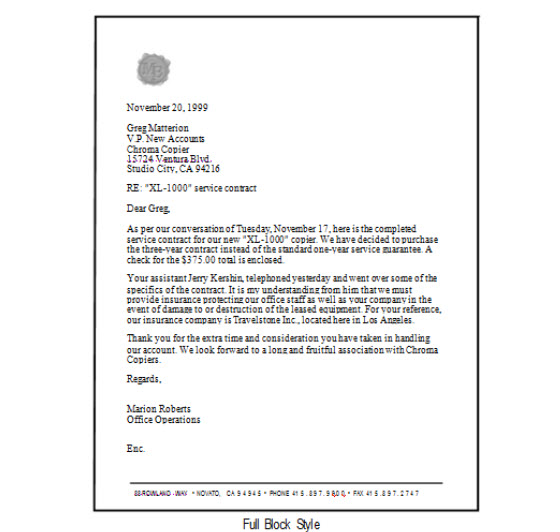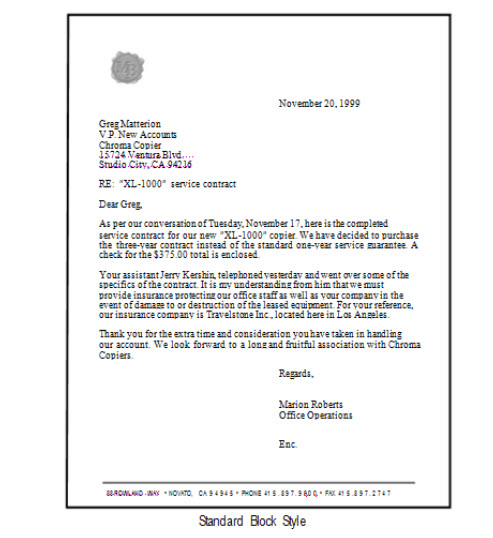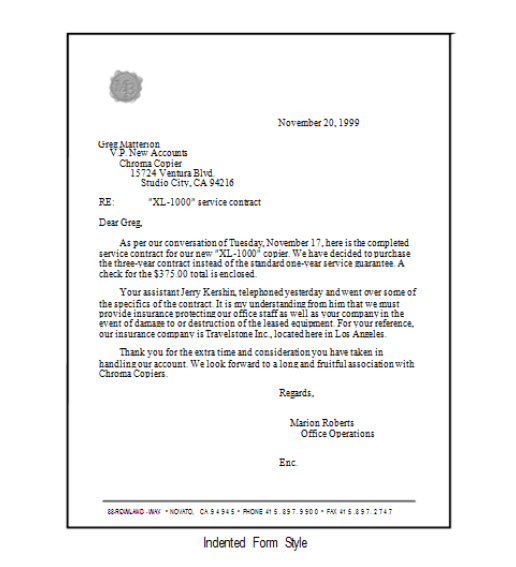The Four Letter Styles
Most traditional business or personal letter styles can be broken down into two basic types: block and indented. Here are illustrations of the four most common forms:
- The Full Block Style
The full block style (below) is the most formal business approach. In this style, type all elements, the Originating Address, Date, the Inside Address, Salutation, Body of the Letter, Complimentary Close, and Reference from the extreme left margin. The paragraphs are not indented.

- The Standard Block Style
The standard block style (Figure 2) continues with all elements flush to the left, with the exception of the Date, the Complimentary Close, and the Reference. These begin at the of the page. This style, while not quite as rigid as the full block style, is still very formal.

- The Semiblock Style
The semiblock style (Figure 3) is perhaps the most common of these four styles. The semiblock style keeps all elements flush to the left except the first line of every paragraph, which is indented five spaces. Setting the Tab key to this spot usually creates the indentation.

- The Indented Form
The indented form (Figure 4) is the most stylized of the four, somewhat difficult to read, and the least often used.

However, styles change with time, so Mavis includes it here. This style requires that you indent the inside address at the left margin as well as with each subsequent line in the address that you indent to the right of the one above:
Lorena Samson
Chair
6900 Melrose Ave.
Los Angeles, CA 90035
The signature line, too, is indented to the right of the Complimentary Close:
Very truly yours,
So far, we have spoken only about one-page letters. Often, however, you will be constructing multiple-page documents. The following are some general guidelines that will help you create the clearest presentation possible.
Before you print out your piece, it is a good idea to preview your work. As with a single-page letter, the look and organization of a letter with many pages is vital. Too many lines on a page or poorly chosen page breaks can take the edge off an otherwise fine work. You can check how your piece will print so that you can adjust page breaks, and so on. Make it a habit to do so.
It is up to you to make sure that the letters that extend to two or more pages do so gracefully, without “widows” or “orphans.” A “widow” is the line that falls at the end of one page and continued on the next. These line breaks can cause lack of continuity in your work and thus make reading your letter more difficult. The worst widows break off with a hyphen in the middle of a word. The balance of the widowed sentence from the previous page is an “orphan.” While technically correct, avoid orphans and widows as they give your document a haphazard look.
Generally, the first page of a multi-page letter ends with the word “(more).” This is a courtesy to your reader and it ensures they will read the balance of your letter. Since you will be striving to end every page with a complete sentence, the reader might not realize that your letter continues. A simple “(more)” tells them that it does.
The following pages of your letter may or may not be numbered. Standard business procedure allows that a simple “Page 2”, and so on, should go on the top left corner of each page. As an identifying precaution, consider adding the name of the addressee and the letter’s date on each page. The top margins of the subsequent pages of your letter can vary in size. Generally, they should start six lines down from the top of the page. The body of the letter should then commence four lines below this. Styles do vary but here is a standard form:
[6 lines]
Page 2
Ms. Lorena Samson
January 1, 2009
[4 lines]
We are continuing to review the night deposit procedures and will present the full report at our meeting.
This section touches only briefly on the basic business or formal letter styles possible, and the examples provided here are only some of the possible formats. The fundamental idea is that, although letter styles may go in and out of fashion, a clear, uncluttered page layout will never let you down.